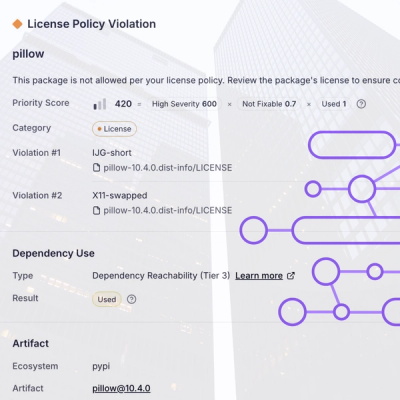
Research
/Security News
Critical Vulnerability in NestJS Devtools: Localhost RCE via Sandbox Escape
A flawed sandbox in @nestjs/devtools-integration lets attackers run code on your machine via CSRF, leading to full Remote Code Execution (RCE).
prosemirror-autocomplete
Advanced tools
prosemirror-autocompleteA plugin for ProseMirror that adds triggers for #hashtags, @mentions, /menus, and other more complex autocompletions. The prosemirror-autocomplete library can be used to create suggestions similar to Notion, Google Docs or Confluence; it is created and used by Curvenote. The library does not provide a user interface beyond the demo code.
npm install prosemirror-autocomplete
Or see the live demo here!
prosemirror-autocomplete allows you to have fine-grained control over an autocomplete suggestion, similar to an IDE but simple enough for @ or # mentions.
import autocomplete, { Options } from 'prosemirror-autocomplete';
// Create autocomplete with triggers and specified handers:
const options: Options = {
triggers: [
{ name: 'hashtag', trigger: '#' },
{ name: 'mention', trigger: '@' },
],
onOpen: ({ view, range, trigger, type }) => handleOpen(),
onArrow: ({ view, kind }) => handleArrow(kind),
onFilter: ({ view, filter }) => handleFilter(),
onEnter: ({ view }) => handleSelect(),
onClose: ({ view }) => handleClose(),
};
// Alternatively, use a single reducer to handle all actions:
const options: Options = {
triggers: [
{ name: 'hashtag', trigger: '#' },
{ name: 'mention', trigger: '@' },
],
reducer: (action) => dispatch(action),
};
// Then add these plugins to the EditorView as normal in ProseMirror
const view = new EditorView(editor, {
state: EditorState.create({
doc: DOMParser.fromSchema(schema).parse(content),
plugins: [...autocomplete(options), ...otherPlugins],
}),
});
The function autocomplete takes handlers or a single reducer and a list of triggers, it returns a two plugins:
[@][mention]); andInputRule plugin that has a series of triggers that are defined in the options.All handlers take an AutocompleteAction as the first and only argument (same as the reducer).
onOpen({ view, range, trigger, filter, type }) — when the autocomplete should be opened
type is the Trigger that cause this actiononEnter({ view, range, filter }) — called on Enter or TabonArrow({ view, kind })
kind is one or ArrowUp, ArrowDown, ArrowLeft, ArrowRightallArrowKeys = true for the triggeronFilter({ view, filter }) — called when the user types, use this to filter the suggestions shownonClose({ view }) — called on escape, click away, or pasteTo use a reducer instead of distinct handlers, use the option reducer: (action: AutocompleteAction) => boolean, which will be used in place of the above handler functions.
By default, each Trigger has a name, and a trigger, which is a string or RegExp. For example, a simple trigger can just use a single string:
import type { Trigger } from 'prosemirror-autocomplete';
const mentionTrigger: Trigger = { name: 'mention', trigger: '@' };
This trigger gets wrapped in a regular expresion:
const equivalentTrigger = /(?:^|\s|\n|[^\d\w])(@)$/;
This does what you want most of the time, ensuring that you don't trigger when writing an email, or if you are writing something else. This is a bit more strict than you might want for a social plugin, which picks up hashtags or mentions anywhere you write them.
If you want this to come up all the time, try:
const peskyMentionTrigger: Trigger = { name: 'mention', trigger: /(@)$/ };
Provide the trigger in the matched group and anything before in a non-capture group ((?:)), this will help you split the action into a action.search and an action.trigger.
name: string: the trigger is passed in the action, you can use this to descriminate handler callstrigger: string | RegExp: used to trigger an autocomplete suggestion - described abovecancelOnFirstSpace?: boolean, cancels the auto complete on first space, default is trueallArrowKeys?: boolean: Use left/right arrow keys, default is falsedecorationAttrs?: DecorationAttrs, passed to the <span> element directly through prosemirrorThe library does not provide a user interface beyond the demo code, you will have to do that when you get an action from the autocomplete plugin. You can either use the handlers onOpen, onArrow, onFilter, onEnter, and onClose or you can define a single reducer that will take over these responsibilities. Note: you cannot use handlers and a reducer. You can also access the original keyboard event on the action, as action.event. If the action was not created by a keyboard event, that property will not be available.
import { AutocompleteAction, KEEP_OPEN } from 'prosemirror-autocomplete';
export function reducer(action: AutocompleteAction): boolean | KEEP_OPEN {
switch (action.kind) {
case ActionKind.open:
handleSearch(action.search);
placeSuggestion(true);
return true;
case ActionKind.up:
selectSuggestion(-1);
return true;
case ActionKind.down:
selectSuggestion(+1);
return true;
case ActionKind.filter:
filterSuggestions(action.filter);
return true;
case ActionKind.enter:
// This is on Enter or Tab
const { from, to } = action.range;
const tr = action.view.state.tr
.deleteRange(from, to) // This is the full selection
.insertText('You can define this!'); // This can be a node view, or something else!
action.view.dispatch(tr);
return true;
// To keep the suggestion open after selecting:
return KEEP_OPEN;
case ActionKind.close:
// Hit Escape or Click outside of the suggestion
closeSuggestion();
return true;
default:
return false;
}
}
An AutocompleteAction is passed to both the reducer and each handler has the following structure:
export type AutocompleteAction = {
kind: ActionKind; // open, ArrowUp, ArrowDown, filter, enter, close
view: EditorView; // the view that the plugin came from
trigger: string; // This is the string that triggered the suggestion
filter?: string; // This is the search string
range: FromTo; // { from: number; to: number }, use to delete the selection
type: Trigger | null; // This is the trigger object passed in
};
You can use something like popper.js to ensure that the autocomplete suggestions stay in the right place on scroll or simply an abolutely positioned <div> in some cases is sufficient.
function placeSuggestion(open: boolean) {
suggestion.style.display = open ? 'block' : 'none';
const rect = document.getElementsByClassName('autocomplete')[0].getBoundingClientRect();
suggestion.style.top = `${rect.top + rect.height}px`;
suggestion.style.left = `${rect.left}px`;
}
If you don't want to use the class provided (which is 'autocomplete') or have multiple on the page, then you can provide your own for any trigger:
const options: Options = {
handler: reducer,
triggers: [
{
name: 'command',
trigger: '/',
decorationAttrs: { id: 'myId', class: 'myClass' },
},
],
};
This will allow you to specify styling of the wrapped decoration (which is a <span>). This can be different based on the trigger type. For example, in the above example you can use a css rule to style the inline span, this is what is done in the demo:
/* The default decoration class. Override with `decorationAttrs: { class: 'myClass' }` */
.autocomplete {
border: 1px solid #333;
border-radius: 2px 2px 0 0;
border-bottom-color: white;
padding: 2px 5px;
color: blue;
}
InputRuleThere are certain times when you want to open up an autocomplete suggestion without the user typing. For example, you might have a command menu under / that shows all commands for users to discover other triggers, where they can discover /emoji and then the UI should move them into an emoji selection or :.
There are two actions:
import { openAutocomplete, closeAutocomplete } from 'prosemirror-autocomplete';
openAutocomplete(view: EditorView, trigger: string, filter?: string)closeAutocomplete(view: EditorView)If the above scenario, the user would trigger an input rule for the first action by typing /emoji and then the onEnter or reducer would call closeAutocomplete(view) and then openAutocomplete(view, ':', 'rocket'), optional 🚀 obviously!
There are a few other packages that offer similar functionality:
prosemirror-suggestions is similar in that it does not provide a UI, if you want a simple UI out of the box you can look at prosemirror-mentions. All three of these libraries trigger based on RegExp and leave the decorations in the state. This is similar to how Twitter works, but is undesirable in writing longer documents where you want to dismiss the suggestions with an escape and not see them again in that area.
This library, prosemirror-autocomplete, works based on an input rule and then a decoration around the chosen area meaning you can target the suggestion specifically and dismiss it with ease.
Made with love by
![]() Curvenote
Curvenote
FAQs
Autocomplete suggestions for prosemirror
The npm package prosemirror-autocomplete receives a total of 9,553 weekly downloads. As such, prosemirror-autocomplete popularity was classified as popular.
We found that prosemirror-autocomplete demonstrated a not healthy version release cadence and project activity because the last version was released a year ago. It has 1 open source maintainer collaborating on the project.
Did you know?

Socket for GitHub automatically highlights issues in each pull request and monitors the health of all your open source dependencies. Discover the contents of your packages and block harmful activity before you install or update your dependencies.

Research
/Security News
A flawed sandbox in @nestjs/devtools-integration lets attackers run code on your machine via CSRF, leading to full Remote Code Execution (RCE).

Product
Customize license detection with Socket’s new license overlays: gain control, reduce noise, and handle edge cases with precision.

Product
Socket now supports Rust and Cargo, offering package search for all users and experimental SBOM generation for enterprise projects.